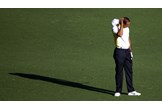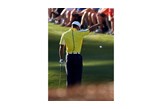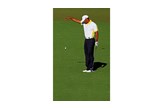Tiger’s ball drop
Published:
Friday April 12, 2013, Augusta National
The 77th Masters is approaching its halfway stage. By the end of the day, Jason Day will have the lead on six under. Chinese 14-year-old Guan Tianlang will have survived the cut, despite being penalised a shot for slow play. And Tiger Woods will find himself ominously placed, just three shots off the lead. But by the time Saturday morning arrives, Woods’ overnight score will have been changed from 1-under to 3-under and his integrity as a golfer called into question. Here’s a detailed account of what happened.
Augusta time 5:30pm
Facing a pitch into the par-5 15th hole, Woods’ third shot hits the pin, spins back and lands in the pond in front of the green. He has three options for his next shot and chooses to play from the original spot of his third shot, which under Rule 26-1 (a) states he must play a ball as close as possible to the point of the previous shot, no closer to the hole. Woods drops, pitches on close to the pin and putts for bogey.
5:45pm
At home in Florida, former PGA Tour tournament director David Eger takes a break from gardening to catch up with developments at Augusta. Rewinding the action, he notices the divot from Tiger’s previous shot is some distance in front of him. “(So) I watched his third shot again, and I see no divot hole. I replayed the sequence again, and then again,” he says. At which point his wife asks him to help with the tomato plants. “I said, ‘Honey, you’re going to have to wait’.”
5:50pm
Eger calls Mickey Bradley, a PGA Tour rules official he knew was working at the Masters but who had left Augusta for the day. Explaining that Tiger would be disqualified if he signed for a score lower than he shot, Eger urges Bradley to alert rules official Mark Russell or Fred Ridley, chairman of the Masters competition committees. “I assumed the officials would take another look, and Tiger would be surrounded by green coats when he came off 18,” says Eger. “They’d interview Tiger as to what happened on 15, he’d adjust his score from a six to an eight for violating Rule 20-7 [playing from a wrong place], and that would be it.”
6:10pm
Alerted to the situation, Ridley and Russell, along with former USGA chairman of rules Jim Reinhardt, review footage of the incident and conclude, without speaking to Woods, that there was no breach of the rule. Responding to Bradley by text and referring to Eger’s claim of a 3-4ft discrepancy, Ridley claims it “was closer than that” and to look at it more closely would be “splitting hairs”. In his view, it was a “non-violation”.
7:30pm
In post-round interviews, Woods explains the drop and inadvertently implicates himself. “I went back to where I played it from, but I went two yards further back and I took, tried to take two yards off the shot of what I felt I hit,” he says. “It worked out perfectly.”
10:15pm
Tiger’s admission sets alarm bells ringing. The Masters Rules Committee reviews the interviews and the shot and at some point in the early hours of Saturday, Ridley calls Tiger’s agent Mark Steinberg to tell him the committee wants to meet Woods later that morning.
8am, Saturday, April 13
In the meeting, Woods is informed that although he was in violation of Rule 26-1 (a) he will not be disqualified, based on Rule 33-7, which gives the rules committee discretion not to DQ a player in exceptional individual cases. The fact that the Masters Rules Committee had ruled on the case the previous day meant it could reconsider and correct its original decision of no penalty and issue Woods with a two-shot penalty rather than a DQ. They issue a statement saying: “The subsequent information provided by the player’s interview after he had completed play warranted further review and discussion with him this morning. After meeting with the player, it was determined that he had violated Rule 26, and he was assessed a two-stroke penalty.”
8:00am onwards
As the judgement filters out, the great and the good of the game line up to play judge and jury. “I think it would have done him a world of good to have disqualified himself,” says Sir Nick Faldo, the most vocal among them. “I think he should have said to the committee, ‘Thank you for your thoughts, but I have broken this rule, and I am going to call it on myself’.” On Twitter, Hank Haney wonders: “What if Tiger comes back to win and eventually ends his career with 19 major victories?”
Woods is unrepentant. “I made a mistake, I took an improper drop and got the penalty,” he later says. “Under the rules of golf I was able to play.”
Dismissing claims that Woods received preferential treatment, amid talk of the need to keep TV viewing figures high, Augusta official Ridley says:
“I can’t control what the perception might or might not be… unequivocally this tournament is about integrity. Our founder Bobby Jones was about integrity, and if this had been John Smith from wherever he would have gotten the same ruling, because it is the right ruling under these circumstances.”
1.45pm
Free to play, Tiger tees off in the third round and opens with a birdie. He ends the tournament four shots behind winner Adam Scott, leaving the world to wonder what if that third to the 15th had not bounced so cruelly off the stick and the heavily-criticised Eger to wonder why he had bothered. “I don’t know if I’d call again,” he later reflected.
The Golf World Verdict
Tiger clearly didn’t aim to cheat, and most likely confused parts 2 and 3 of Rule 26-1. The bigger issue was his conduct after the ruling. Had he admitted he was lucky to escape through a loophole, the world might have looked more favourably upon him. Had he walked away, admitting that his action was, if not illegal then against the spirit of the game, he’d have departed with his reputation rebuilt. Sadly, Tiger being Tiger, that was never an option.
Tiger’s options
The three choices Woods could have taken with a one-stroke penalty.
Option 1: Tiger could have played his 5th shot from the drop area – an option under the Tournament’s Local Rules.
Option 2: He could drop a ball, keeping the point at which the original ball last crossed the margin of the water hazard directly between the hole and the spot on which the ball would be dropped. There’s no limit to how far behind the water hazard he could have gone under this option.
Option 3: He could return to the spot of his original shot and take a drop (i.e. proceed under stroke and distance). Under Rule 26-1 (a), Tiger had to drop and play a ball “as near as possible from which the original ball was last played”. The option he took.



